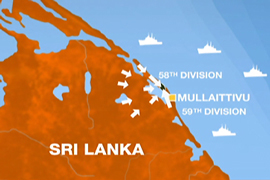Sri Lanka says rebels surrounded
Troops say they have captured the final strip of northeastern coast held by the Tamil Tigers.

Brigadier Udaya Nanayakkara, the defence ministry spokesman, told Al Jazeera: “After this linking up of two divisions, the entire coastal stretch has been denied to the LTTE. … We have completely denied the LTTE’s Sea Tigers access to the sea.
“The LTTE will have no other choice but to surrender or commit suicide.”
LTTE leaders’ fate
Government forces have been hunting for Velupillai Prabhakaran, the LTTE chief, and his deputies for months, but it is unclear if they are still in the coastal strip or have already fled overseas.
“They are slowly giving up,” Nanayakkara said, referring to the Tamil Tigers.
“They are blowing up whatever arms and ammunition they have.”
 |
Mahinda Rajapaksa, the president of Sri Lanka, had vowed on Thursday to end the war within 48 hours.
He also said civilians in the war zone would be quickly freed.
“The freedom of the Tamil civilians held hostage by the LTTE is near at hand and the rescue of all civilians in the small patch of land held by the LTTE will be done in 48 hours,” Rajapaksa was quoted as saying.
In his comments to Al Jazeera on Friday, Nanayakkara stressed that the “main aim is to rescue civilians. Rescue operations are going on.”
He claimed that once the real figures of civilians trapped in the conflict zone become known, those cited by humanitarian organisations would be exposed as exaggeration.
Escape from war zone
About 200,000 civilians have escaped the war zone in recent months and are being held in overwhelmed displacement camps.
Nanayakkara told the AFP news agency that up to 9,347 civilians escaped on Friday alone by wading across a lagoon.
More than 13,000 civilians have fled since Thursday, he said.
Still, international concern has grown for the thousands still trapped.
| Focus: Sri Lanka | ||||||

|
The International Committee of the Red Cross (ICRC) has given warning of “an unimaginable humanitarian catastrophe” for the hundreds of wounded.
“No humanitarian organisation can help them in the current circumstances. People are left to their own devices,” Pierre Krahenbuhl, the ICRC’s director of operations, said.
Ban Ki-moon, the UN secretary-general, has sent his chief of staff, Vijay Nambiar, to Sri Lanka for a second time to try to bring the conflict to a peaceful conclusion.
Nambiar is expected to meet senior government officials after he arrives on Saturday, and push for ways “to secure the safety of the 50,000 to 100,000 civilians remaining inside the combat zone”, Gordon Weiss, a UN spokesman, said.
Reports of the fighting are difficult to verify because the government has barred most journalists and aid workers from the conflict zone.
Western appeal
In the latest appeal to Sri Lankan authorities, France and Britain urged Colombo to live up to its commitments and avoid using heavy artillery.
In a letter addressed to President Rajapakse released in Paris, Bernard Kouchner and David Miliband, the two countries’ foreign ministers, said that “there have been a number of reports that your security forces have not lived up to these commitments”.
Up to 7,000 civilians were killed and 16,700 wounded in the fighting from January 20 until May 7, according to a UN document given to The Associated Press by a senior diplomat.
Since then, doctors in the war zone say more than 1,000 civilians have been killed in a week of heavy shelling that rights groups and foreign governments have blamed on Sri Lankan forces.
Sri Lanka denies firing heavy weapons into the war zone..
Navi Pillay, the UN’s human rights chief, has said both sides may be guilty of war crimes.
